#izzy loves lew
Text

another day of staring at this photo and needing a cold shower
#izzy talks#how dare he look like that#fuck lewis pullman for looking this good#it’s a crime he kept bobs shirt on :(#lewis pullman#izzy loves bob#izzy loves lew
449 notes
·
View notes
Text
190. porky at the crocadero (1938)
release date: february 5th, 1938
series: looney tunes
director: frank tashlin
starring: mel blanc (porky)

at long last, frank tashlin has succumbed to putting porky on a diet. this is the first tashlin short to have a slimmed down porky, officially putting an end to “fat porky”’s reign.
the story credit goes to lew landsman—a bit of an anomaly, considering this is his only credit. much of the scoop on him has been lost to the sands of time, but evidently he was a gag artist, selling comic drawings to magazines and even touting showings of his art throughout the ‘40s and ‘50s. you can read more about him here.
porky aspires to be a bandleader at the prestigious crocadero (a parody of the cafe trocadero, a bumping nightclub on the sunset strip from 1934-1947), but quickly realizes he’s too poor to afford its flashy admittance fee. he works as a dishwasher, hoping to catch a whiff of the festivities, but is quickly let go after he proves too incompetent for the job. nevertheless, an impromptu change in plans finds porky at the bandstand conducting a number of acts, including a high-energy cab calloway finale.
the typography of the title card melts away, the camera panning out as we get a full view of the crocadero, illuminated by the moonlight and its flashy neon sign. pan back in to the sign and fade to a standee:

all of the selections are references to pieces of music, with said music serving as accompaniment. the score begins with “little man, you’ve had a busy day”, switches to “in the shade of the old apple tree”, and closes with a carl stalling favorite, “the lady in red”.
pan over to porky, eagerly ogling the sign. volney white’s animation and mel blanc’s vocals combine to make an energetic performance that will only grow in fervor. “hot duh-dee-duh-dee-duh-diggity dog! all thuh-the-thee-the big shots in person!” the detail of porky’s little hat flipping around, staggering in time to his stutter, is not only funny, but elevates the energy of the sequence. “someday, i’m uh-guh-geh-uh-gonna lead a band, too! s-see?”
porky unfurls a diploma, to which we get a close-up of his not-so-trustworthy credentials (fingernails and all):
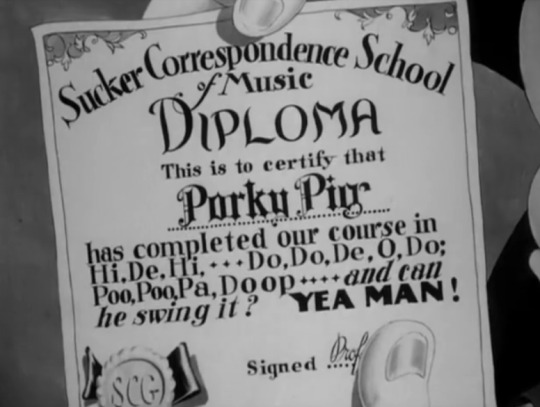
volney’s animation continues to be full of character as porky blabs on about how he’s gonna become a famous bandleader. “and meh-muh-mee-mm-maybe i’ll be eh-feh-eh-famous, like eh-leh-lee-le-leopold eh-seh-stokowski!”
a nice change in camera angles as we turn to an upshot of porky, furiously conducting his imaginary band to a rousing rendition of “poet and peasant overture”.

the mood changes from fervent conductor to crooner as he chooses to mimic rudy vallee, conducting along to vallee’s 1937 “vieni, vieni”, complete with a hilariously amiable facial expression--a stark contrast to the fit he was throwing mimicking stokowski just seconds prior.
another seamless transition in tone to an impression of eh-buh-bee-beh-benny goodman, the song this time being “sweet georgia brown” in the stylings of the king of swing himself. the changes in mood and tone, in both the animation and the music, are as smooth as butter, especially for such drastic shifts in expression. frank tashlin doesn’t skip a beat with his pacing. this is especially true as the camera pans over to another nearby sign, a hilarious sight gag quickly putting an end to porky’s festivities:

dejected, porky rifles in his pocket and pulls out a lone coin emblazoned with a skunk—“one scent”. he trudges along solemnly, away from the crocadero, when all of the sudden a sign catches his eye: BOY WANTED. though porky has been slowly growing more consistent in his characterization, his age still fluctuated from picture to picture. frank tashlin would also portray him as a young boy in wholly smoke just a few months later.
tashlin flaunts his need for speed as porky wastes no time doing the signature volney white eye take and darting into the crocadero, a cloud of dust and the swinging of the doors serving as the only indication of his presence just milliseconds prior.

although the sign doesn’t elaborate on what job it is that porky is doing, the tower of dishes blocking the screen as we fade in to the new scene answers any lingering questions. pan out to porky, happily scrubbing away, while his boss, a pretentious walrus whose vocal stylings are hilarious and borderline incomprehensible orders him around. the bargain—if porky does his job, then he can “watch the orrrrrrchestrey, maybe, hmmm?”
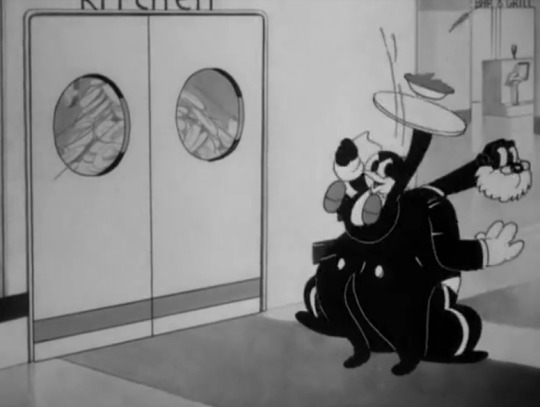
a throwback to the days of working with disney, carl stalling “mickey mouse”’s a little penguin waiter—that is, his quick little steps are fervently timed to the jaunty tinker of an xylophone. the walrus blocks the diminutive penguin, peddling a platter of soup. after they inadvertently do a tango of side-stepping, the penguin wordlessly slides down the walrus’ back, zigzagging around a sea of tables, and right over to a lone giraffe, elevating the table like a car jack to fit the gjraffe’s height. the giraffe laps up his soup with ease. though not the funniest gag ever, tashlin’s quirks—the quick timing, hiding the penguin behind the plethora of tables, etc, make it more endearing.
back to porky, carrying a dangerously tall tower of plates with him. a fly causes him to nearly spill his goods, but ducking in place renders the pig safe. that is, until he throws all of the dishes in the air, swatting the fly spastically. the music cue of porky ducking, looking around to make sure the fly is gone, sounds eerily similar to the stylings of norman spencer, who scored the cartoons up until mid-late 1936.
without a break in pace, porky catches all of the dishes he threw into the air in one fell swoop. more buttery pacing from tashlin, who is able to switch tones and moods at lightning speeds without missing a beat. this is INCREDIBLY difficult to pull off, and he makes it look too easy.

as to be expected, the fly lands right on porky’s snout. instead of attacking it without hesitation, porky slowly reaches for a spoon on the kitchen counter... and THEN disregards his duties as dishwasher, carelessly tossing his pile of dishes aside to swat furiously at his foe.
the pompous walrus from before spots porky’s silhouette from outside the kitchen doors, flailing and waving around like a madman. “der loafer!” his boss interprets porky’s frantic waving of the spoon as a frantic imitation of a bandleader, promptly tossing him out. porky recovers in the back alley, left with his diploma and metaphorical birds of cartoon pain as the boss scolds “today, you are a ham!”--a take on the bar mitzvah declaration “today, you are a man”, which has been spoofed previously in cartoons such as egghead rides again.
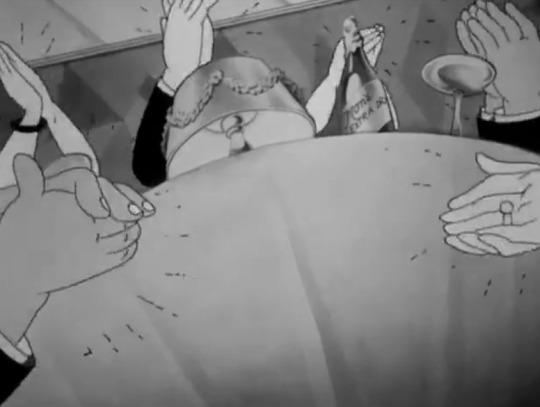
it doesn’t take long for the boss to eat his own words. frank tashlin does a great job of creating a genuinely anxiety inducing mood as a crowd of people, now filling the crocadero, chant “we want mu-sic! we want mu-sic! we want mu-sic!” the musical accompaniment is more akin to the stylings of scott bradley, in the sense that it’s purely atmospheric and contextual, rather than an actual melody. the chanting and disconcerting music get louder as we cut to dramatic up shots of hands clapping to the beat, down shots of foots stamping, etc. it’s genuinely unnerving--and the manager agrees, pacing circles around his office, muttering incoherently to himself about the absence of “the musicmaker”.
knocking on the door serves as a symbol of hope as the manager whips around. “who’s dere?”
“telegram, i bet’cha!” inside bursts a total loon of an old man, his long, white beard whipping in the wind as he does donuts on his bicycle inside the manager’s office. if it weren’t for his looks and speech patterns, which already tell a story, carl stalling’s score of “the woods are full of cuckoos” certifies that this old coot definitely has some screws loose.
the old coot reaches into the depths of his beard and pulls out said telegram. “y’ owe me sixty cents, i bet’cha.” the manager unceremoniously dumps a handful of coins into the coot’s possession, who does a few more donuts in the office, indicating his exit. that is, until he suddenly halts, tipping his hat to bid “g’bye, i bet’cha.” such a scene is nonsense--and it’s hilarious nonsense rather than perplexing nonsense. it makes no sense, and yet it’s speedy enough to get its point across AND not overstay its welcome. had the same gag been executed by someone such as ben hardaway, who probably would have LOVED this gag, it would have been milked to death and bloated to ensure the audience “got it”. here, frank knows when to start and when to stop, an incredibly valuable skill not all directors possess.
contents of the telegram include a rather morbid nod to the hit ‘20s song “i faw down an' go boom”:

to add insult to injury, the old coot sticks his head in the door and adds “yeah, and they won’t come ‘t all, i betcha!” before slamming the door. though i can’t place the animator, the style of the animation looks eerily similar to that of izzy ellis’, from the spiral motion lines to the thin, squished look of his face. izzy ellis would animate in the clampett unit after leaving ub iwerks’ studio, later animating under norm mccabe, frank tashlin himself, bob clampett again, and then bob mckimson. an example of some of his work under frank tashlin here.
back to the crowd, still demanding their music in the same unnerving drone. the manager continues to pace in his office, until a bright idea hits. “that sving dishvasher! i must get him back schnell!”
a moment of frank tashlin greatness: the entire cartoon screeches to a halt as a narrator explains “ladies and gentlmen, ‘schnell’ means ‘quick’!” and, just like that, cartoon hijinks resume. this joke is hilarious 83 years later--imagine the reaction it evoked from theatergoers in 1938. once more, the matter-of-fact execution of the gag is what sells it. no build up, no cool down, no bloating of anything. short, sweet, and to the point. it’s so hilariously and purposefully redundant that you can’t NOT laugh at it.
speaking of quick, that would be an understatement to describe the rapid cutting after the fact. the manager rushes outside, whipping around street corner after street corner to find the dejected dishwasher he berated just minutes prior. he finds his target, grabbing porky and rushing backwards--the same way he came at the same exact lightning speed--all while monologuing about how porky can be a bandleader and break all of the dishes he wants.
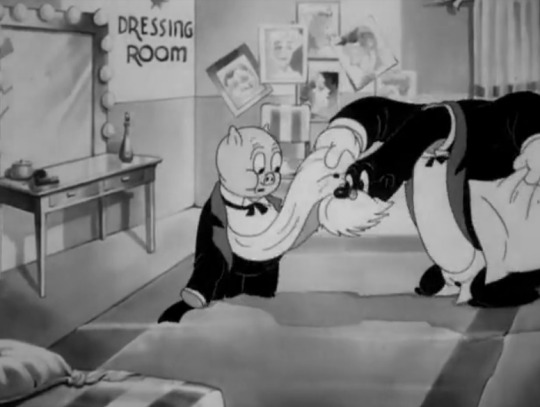
again, no breaks in momentum whatsoever as the bandleader tosses a nonplussed porky into a bandleader’s outfit, stuffing a pillow under his shirt (had this cartoon been made a few months prior, there’d be no need for a pillow!) and giving him a fake mustache/curl of hair via makeup. “pull de vool over dere eyes!”
thus cues the music portion of the cartoon. a spotlight shines on a sign introducing porky as “the jazz king”, much to the pleasure of the audience. a giraffe in the orchestra introduces the song with a clarinet solo of “rhapsody in blue” before getting down to business.
porky, dressed as paul whiteman, conducts whiteman’s “avalon”, as indicated by the music stand. volney white does some great animation here--porky struggles to keep his own weight afloat, his giant pillow-stomach sinking to the ground. he readjusts himself a few times, enjoying the spare seconds of peace where his outfit stays intact, only for the same charade to repeat. fun eye takes and volumetric animation from volney. it’s no coincidence that he was one of tashlin’s best animators.
the crowd shots in this cartoon are not to be overlooked--kudos and apologies for the poor people who had to ink and paint all of that! the crowd dances along to the stylings of porky’s music, including a pair of kangaroos and their joeys slow dancing together.

back to the little penguin waiter from before, tinkering along to deliver a drink. a spare trombone sucks up all of the goods in the glass, prompting a hilarious grimace from the penguin who just stands still, silently glowering before traipsing backwards (mickey mouse timing and all) to refill.
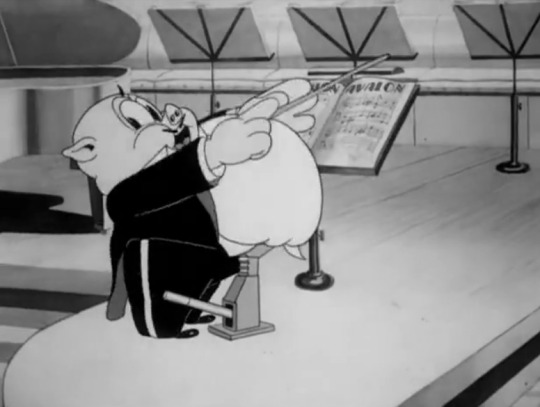
cut to porky, who appears much more jovial. a clever pan out reveals that he’s enlisted in the help of a car jack to keep his extra weight afloat. and, with that, curtains (animation reused from the introduction to tashlin’s porky’s romance) close out on the pig. applause from the audience.
next up, “guy lumbago and his boiled kanadians”, a not-so-flattering nod to guy lombardo and his royal canadians. porky, dressed as a canadian mountee, directs “cryman lumbago”. carmen lombardo, brother to guy, was often poked fun at for the excessive vibrato in his voice--people would liken him to sounding like an old man on his last legs. not only that, but even by the ‘30s, guy lombardo’s music was often dismissed as slow, sappy “old person’s music”. the 1954 woody woodpecker cartoon, real gone woody, also makes fun of lombardo, also dubbing him as “lumbago” and calling him a square.

indeed, cryman lumbago is a decrepit old man with--you guessed it--lumbago, singing in a hilariously obnoxious vibrato. even the dancers in the crocadero stagger along to his vibrato, their dancing stuttering. the benign facial expressions of the crowd, despite all of this, is the perfect cherry on top. one wonders if guy/carmen lombardo ever saw this cartoon, and how they reacted to it...
just as the gag threatens to overstay its welcome (and, admittedly, it has), a screwball assistant who looks like a relative to another random screwball in porky’s duck hunt scoops lumbago into a wheelchair and wheels him off stage. the audience applauds, and there’s a feeling that they aren’t just applauding the music.
cue the most controversial, uncomfortable, yet also complex part of the cartoon: a tribute to cab calloway, or, as he’s dubbed here, cab halloway.
for today i’ll spare you the imagery, but we’re greeted by a (thankfully) rare anomaly in the porky pig-verse: porky and his orchestra are dressed in blackface, conducting a rousing rendition of “chinatown, my chinatown”.
obviously, any and all blackface is abhorrent, but this is an interesting case. it’s clear that this was meant to be an homage and celebration of cab calloway’s music. a certain level of care seems to have been put into this sequence—it’s not a cheap throwaway “haha blackface” gag purely just for laughs. the animation is FILLED with a surprising amount of energy and vitality, and the vocals of the calloway impression are eerily spot on. analyzing the animation from a technical standpoint, it’s VERY skillful. it is NOT easy to convey such high energy and such elasticity. the animation is vivid, rapid, and invigorating. for 1938 especially, such energy is jarring. this feels more like the climax of a 1945 bob clampett cartoon, not a run of the mill 1938 porky pig cartoon.
BUT, with that said, it’s still extremely uncomfortable--blackface is blackface, and just because the techniques behind it are good doesn’t mean the material being animated is good. as i mentioned, the intentions don’t entirely feel as nasty as other examples we have/will seen, but that doesn’t negate the harm it does. you can have affectionate homages to cab calloway and his music without blackface--look at betty boop’s snow white. plus, because the song is “chinatown, my chinatown”, any nuance this scene had is discredited when porky switches from blackface to dressing up as a stereotypical chinese man. uncomfortable and unnecessary--THAT is a cheap throwaway gag.
nevertheless, it’s not in my place to preach about what is racist and what isn’t. speaking purely from a technical standpoint--the techniques and processes that went into the animation itself--this is a very impressive performance. high energy in both music and animation. the elasticity, speed, all of it is very impressive. the content BEING animated, however, has aged like rotten milk. though this isn’t as meanspirited as other instances that we’ll explore, it still absolutely has its problems and definitely encourages mindful thinking.

regardless, the number ends to uproarious applause, and porky successfully lives his dreams of being a bandleader. the cartoon closes on the penguin waiter, once more peddling a drink. just as the offscreen trombone threatens to steal his drink, the penguin swallows it all in one go and blows a raspberry to the trombone as we iris out.
an interesting entry for sure. frank tashlin’s talents cannot and should not be understated--his speed and timing of the cartoon are certifiably one of the most impressive aspects of the cartoon. indeed, a lot of fun music in this one, whether that be underscores or otherwise. the design of the cartoon holds up very well--tashlin’s streamlined backgrounds and layouts are always a treat to look at. porky is very endearing, especially in the beginning with his imitation of all of the bandleaders, and the incomprehensibility of the walrus is too funny not to laugh at.
of course, the elephant in the room is the ending tribute, which we already discussed. from a technical standpoint, the vivacity of the animation should absolutely be commended and appreciated, especially this early on. the music is VERY fun. but blackface is blackface, and it just hasn’t aged well and comes off as uncomfortable--at least--regardless.
with that, whether you choose to watch this cartoon is up to you. i think this is definitely one of tashlin’s best porky cartoons, and despite its gags and references that have now become dated, it still serves as an enjoyable watch. the whole blackface thing, however, is why this isn’t a cartoon i frequent often. i would trepidatiously recommend this, either skip the calloway sequence or watch it with an open mind. in all, a fun cartoon that i unfortunately can’t quite appreciate to its fullest extent.
with all that said, here’s a link!
15 notes
·
View notes
Text
Tag Game
Rules: you can usually tell a lot about a person by the type of music they listen to! Put your favourite playlist on shuffle and list the first ten songs, then tag 10 people. No skipping!
Thank you @readstudyhike for tagging me!
I tend to listen to one album/artist at a time depending on how I’m feeling, the season, etc. However, I do have a playlist for all the random songs I enjoy, which is the one I’ll be using. So, without further ado...
Life is a dance - Chaka Khan with Lew Hahn
Moderation - Florence + The Machine
Pitfalls - Sistek ft. Tudor & Amy J Pryce
How Deep Is Your Love - Bee Gees
Want You Back - Haim
21st Century Blues - The Wombats
Cloudbusting - Kate Bush
White Tiger - Izzy Bizu
Age of Consent - New Order
May I Have This Dance - Meadowlark
A fairly random list but a surprisingly ok representation of my music taste!
I’m pretty new so I’m tagging blogs I really enjoy! No worries if you’ve already done it or it’s not your thing!
Tagging:
@serendistudy @aliciavstudies @kjemi @ggsstudies @fiercelittlestudyblr @studyburst @prehistoricstudying @bea-estudiando @quaternioninaskirt @fivestarstudying
6 notes
·
View notes
Text
TIN PAN ALIAS
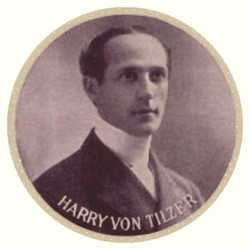
They're no longer the household names they once were. In fact their names were not really their names. But between them Harry and Albert Von Tilzer were two of the more successful and prolific songwriters and publishers on Tin Pan Alley, and many of their songs are familiar today as icons of the so-called Gay Nineties and early 1900s. One of them still gets played every day there's a baseball game.
Harry and his brothers were not born Von Tilzers. Harry was born Aaron Gumbinsky or Gummblinsky to Polish Jewish immigrants in Detroit in 1872. He grew up in Indianapolis, where the brothers were all born. The family shortened the name to Gumm, leading to the often-repeated misinformation that Frances Gumm, better known as Judy Garland, was Harry's niece. In fact, her father Frank Gumm was not one of the Gumbinsky/Gumm/Von Tilzer brothers, but a cracker from Tennessee (and predominantly homosexual, interesting when you consider Garland's complex personal and professional relationships with gay men later, not to mention Liza's).
At fourteen Harry Gumm ran away to join the Cole Brothers Circus. He played piano and wrote songs for a traveling theater troupe and changed his name on the road, taking his mother's maiden name and adding the Von for a touch of class. His brothers, all of whom went into the music business after him, followed suit. Making for more confusion, in 1929 a Helen Von Tilzer would marry one of the Marx Brothers -- Gummo, of course. Because of that preposterous-seeming coincidence she's often written up as Harry's sister, but in fact she was born Helen Theaman in New York. Von Tilzer was her first husband's name, and he seems to have been a real Von Tilzer, also not related to Harry and the fake Von Tilzer clan.
Harry worked in burlesque, with medicine shows and in vaudeville, specializing, naturally, in "Dutch" (German) routines. In 1892 he arrived in New York City by train as a groom for a carload of horses. He had one dollar and sixty-five cents in his pocket. For the next six years he struggled, playing saloon piano and writing songs that Tony Pastor and others bought from him at two bucks each.
According to David A. Jansen's Tin Pan Alley: An Encyclopedia of the Golden Age of American Song, Harry wrote his first hit under some duress. He and lyricist Andrew B. Sterling were sharing a furnished room on East Fifteenth Street in 1898 and were "three weeks behind on their rent. When a final bill was slipped under their door, they used the paper to write a chorus and then a verse of what turned out to be their first successful publication, 'My Old New Hampshire Home.'" It was classic barbershop quartet treacle. William Dunn of the Orphean Music publishing company paid them fifteen dollars for it -- a week's rent on the room -- and proceeded to sell more than a million copies in sheet music.
Then Dunn was bought out by Louis Bernstein and Maurice Shapiro, founders of one of Tin Pan Alley's longest-lived hit factories -- it still exists as Shapiro Bernstein & Co., with a catalogue that includes "Ring of Fire," "Yes! We Have No Bananas," "Walk on the Wild Side" (the original, not Lou Reed's song) and the immortal "Wolverton Mountain." They paid Von Tilzer four thousand dollars, a considerable sum in those days, to join them as a partner in the firm. A few years later he would leave them and start his own publishing company.
In 1900 he was relaxing in a whorehouse (or just at a party, depending on the source), noodling on the piano to some lyrics handed him by the British lyricist Arthur Lamb. When Harry saw the girls around him crying, he figured he'd noodled up a smash hit. It was. "A Bird in a Gilded Cage" sold more than two million copies of sheet music, and was one of the most popular weepers of the age, a song we still associate more than maybe any other with late Victorian mawkishness. This time Harry earned far more than fifteen bucks.
He and Lamb collaborated on two more tearjerkers in 1902, "The Banquet in Misery Hall" and the equally lugubrious "The Mansion of Aching Hearts," which a few singers made into hit recordings. That same year a scrawny Jewish kid from the Lower East Side went busking in the saloons on the Bowery, belting out "Mansion" in a raspy tenor to the pie-eyed sailors and hookers who tossed pennies at him. That kid, Izzy Baline, went up to Tin Pan Alley on Twenty-Eighth Street to meet Von Tilzer, who hired him as a song plugger and "boomer." A boomer was a plant in the audience at the music hall or vaudeville house whose job was to cheer and shout "Encore!" when the publisher's new song was performed. Von Tilzer, who was an expert plugger and boomer himself, showed Izzy the ropes. Izzy, who would invent his own German-sounding professional name, Irving Berlin, went on to eclipse his mentor's fame.

But Von Tilzer was no slouch. "Wait 'Til the Sun Shines, Nellie," "I Want a Girl (Just Like the Girl Who Married Dear Old Dad)," "In the Sweet Bye and Bye" and "I Love My Wife, But Oh You Kid!" were all major hits, and he wrote thousands more. That was not unusual. In the crowded Tin Pan Alley milieu, where publishing companies were stacked four and five stories high door-to-door, the competition was brutal, the pace ferocious and the ruling business model crudely simple: Throw as many songs at the public as you can possibly churn out, and hope one sticks once in a while. The lists of songs published on Tin Pan Alley in its glory years, roughly the 1880s through the 1920s, are stupefyingly long -- tens of thousands of songs, hurled at the public in live performances, as sheet music and piano rolls, on recorded wax cylinders, in early versions of coin-operated jukeboxes, on phonograph discs after the introduction of the affordable Victrola in 1906, and eventually on radio. Almost all of those tens of thousands of songs are forgotten now. In fact the vast majority barely made an impression when they were new. You just kept cranking them out, praying for a hit now and again.
Von Tilzer was out there pitching with the best of them. Like all serious Tin Pan Alley composers he jumped on every band wagon that rolled down Twenty-Eighth Street. He wrote Irish and "Dutch" numbers when they were fads, beer-drinking songs when they came into fashion (including one called "Under the Anheuser Busch"), schmaltzy kiddie songs, and songs capitalizing on every new dance craze, from the bunny hug to the turkey trot to the hesitation waltz. He threw three of them together in one song, "You Can Tango You Can Trot Dear but Be Sure and Hesitate." He wrote novelty songs like "The Ragtime Goblin Man" and topical ones like "Old King Tut," a hit for Sophie Tucker the year after Tut's tomb was discovered in 1922.
He also wrote several hit coon songs. Coon songs spun off from minstrel shows in the 1880s. In the 1890s and 1900s hundreds and hundreds of songs with "coon" in the title were published, usually sung to ragtime tunes. They often replaced the Old Plantation nostalgia of the traditional minstrel song with ruder, more overtly racist stereotypes. They were hugely popular, and Von Tilzer wrote his share, songs like "Alexander" (familiar to audiences then as a hifalutin' name for a blackface minstrel character), "Mammy's Kinky-Headed Coon," "My Lady Hottentot" and "Rufus Rastus Johnson Brown." Performers of old-timey music still record that one, though it may be best known for the 1970 funk version by the great Rufus ("Do the Funky Chicken") Thomas. In 1911, Berlin would upstage Von Tilzer's "Alexander" with his own ragtime-y coon song, "Alexander's Ragtime Band." Any similarity to his mentor's hit was purely intentional.
By the middle of the 1920s Von Tilzer had composed something like two thousand published songs, including a dozen million-sellers and as many as a hundred that sold half a million. His output slowed down in the later 1920s and 1930s, but he still credibly claimed to have written some eight thousand tunes. Like many Tin Pan Alley greats, including Berlin, he did it without ever learning to read or write a note of music.
Time and tastes moved on. Harry quietly lived out his last years in the Hotel Woodward, a Broadway establishment favored by show folk, and died there in 1946.
Meanwhile, Harry had brought Albert and the other brothers to New York. Jules worked for Harry. Will started a song publishing company, and Albert and Jack partnered in another. Albert was also a songwriter. He and vaudevillian Jack Norworth collaborated on the giant "Take Me Out to the Ball Game" in 1908; according to an unconfirmed but persistent legend, Albert never actually saw a ball game until the late 1920s. Some of Albert's other hits include "Put Your Arms Around Me, Honey," "I'll Be With You in Apple Blossom Time," the minstrel song "Down Where the Swanee River Flows" (a hit for Al Jolson in blackface), the Prohibition lament "The Alcoholic Blues" ("No more beer my heart to cheer/ Goodbye whiskey, you used to make me frisky/ So long highball, so long gin/ Oh, tell me when you comin' back agin"), the Hawaiian-themed ragtime hit "Oh, How She Could Yacki Hacki Wicki Wacki Woo," and another novelty hit, the zany bum-diddy-bum jungle number "Oh By Jingo!" with lyrics by Lew Brown. ("We will build for you a hut/ You will be our favorite nut/ We will have a lot of Oh By Gollies/ And we'll put them in the Follies.") Born Louis Brownstein in Odessa, Brown had fled the pogroms with his family and settled in the Bronx. In a long career he collaborated with many Tin Pan Alley and Broadway composers on classics like "Life Is Just a Bowl of Cherries," "You're the Cream in My Coffee," "Sunny Side Up" and "That Old Feeling." It was guys like Brown, the Von Tilzers and Berlin whom the rabid anti-Semite Henry Ford had in mind when he ranted, "The people are fed from day to day on the moron suggestiveness that flows in a slimy flood out of 'Tin Pan Alley,' the head factory of filth in New York which is populated by the 'Abies,' the 'Izzies,' and the 'Moes'..." Ignoring him, lots of people recorded the moron suggestiveness of "Oh By Jingo!" -- Danny Kaye, Spike Jones, Stephane Grappelli and Chet Atkins among them.
Following the addition of sound to commercial movies, the studios lured more and more of the music business out to Hollywood in the 1930s. After all, the first hit talkie, The Jazz Singer, was really a singie. Albert went too. He worked in film and tv, mostly contributing to soundtracks of now obscure pictures. He died in L.A. in 1956. By that point much of the Von Tilzer catalogue, especially the older and mushier songs, had faded away, except at ball games. Then in 1958 Lawrence Welk, than whom no one loved old-fashioned schmaltz more, bought the catalogue and engineered a Von Tilzer revival. When the Songwriters Hall of Fame began in 1969, Harry and Albert were among the first voted in.
by John Strausbaugh
#John Strausbaugh#The Chiseler#Harry von Tilzer#Tin Pan Alias#I want a Girl Just Like the Girl Who Married Dear old Dad
3 notes
·
View notes
Text
brb as i cry
credit: weareattaboy
183 notes
·
View notes
Text

he looks so good in this interview i could die
40 notes
·
View notes
Text

oh lew🥰
29 notes
·
View notes
Text

im sick with feralness
#jesus fucking christ lewis#did you have to do that#my lew lew <3#rhett abbott#fuuuck#izzy loves rhett#rhett abbott <3#southern bob supremacy#lewis pullman#outer range#rewatching for the 3rd time#not tgm
158 notes
·
View notes